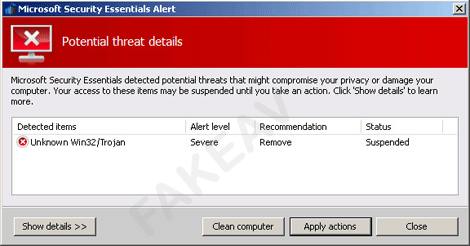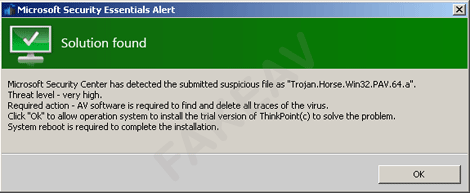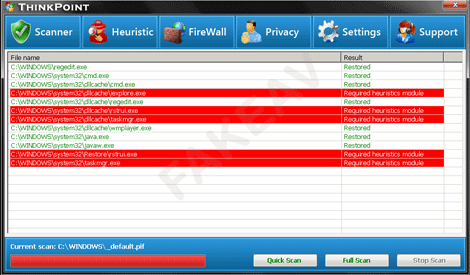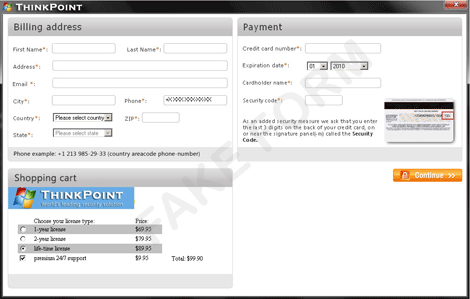TROJ_FAKEAV.THK
Windows 2000, XP, Server 2003


Threat Type: Trojan
Destructiveness: No
Encrypted: No
In the wild: Yes
OVERVIEW
The added .JOB files (scheduled tasks) attempt to access a URL. The said URL only displays a nonmalicious image when accessed. It may require additional parameters to download other possibly malicious file(s). It displays certain graphical user interface (GUI) upon execution.
This Trojan does not have any backdoor capability.
This Trojan arrives on a system as a file dropped by other malware or as a file downloaded unknowingly by users when visiting malicious sites.
It deletes itself after execution.
It displays fake alerts that warn users of infection. It also displays fake scanning results of the affected system. It then asks for users to purchase it once scanning is completed. If users decide to purchase the rogue product, users are directed to a certain website asking for sensitive information, such as credit card numbers.
TECHNICAL DETAILS
714,240 bytes
PE
Yes
10 Dec 2010
Drops files, Connects to URLs/Ips, Displays windows
Arrival Details
This Trojan arrives on a system as a file dropped by other malware or as a file downloaded unknowingly by users when visiting malicious sites.
Installation
This Trojan drops the following copies of itself into the affected system:
- %Application Data%\hotfix.exe
(Note: %Application Data% is the current user's Application Data folder, which is usually C:\Windows\Profiles\{user name}\Application Data on Windows 98 and ME, C:\WINNT\Profiles\{user name}\Application Data on Windows NT, and C:\Documents and Settings\{user name}\Local Settings\Application Data on Windows 2000, XP, and Server 2003.)
Autostart Technique
This Trojan adds the following registry entries to enable its automatic execution at every system startup:
HKEY_CURRENT_USER\Software\Microsoft\
Windows NT\CurrentVersion\Winlogon
Shell = %Application Data%\hotfix.exe
Other System Modifications
This Trojan adds the following registry entries:
HKEY_CURRENT_USER\Software\Microsoft\
Windows\CurrentVersion\Internet Settings
WarnOnZoneCrossing = 0
HKEY_CURRENT_USER\Software\Microsoft\
Windows\CurrentVersion\Internet Settings
WarnOnPostRedirect = 0
HKEY_CURRENT_USER\Software\Microsoft\
Windows\CurrentVersion\Internet Settings
WarnonBadCertRecving = 0
HKEY_LOCAL_MACHINE\SYSTEM\CurrentControlSet\
Services\Schedule
AtTaskMaxHours = 48
Dropping Routine
This Trojan drops the following files:
- %Windows%\Tasks\At1.job - scheduled task pointing to a URL
- %Windows%\Tasks\At2.job - scheduled task pointing to a URL
- %Windows%\Tasks\At3.job - scheduled task pointing to a URL
- %Windows%\Tasks\At4.job - scheduled task pointing to a URL
- %Windows%\Tasks\At5.job - scheduled task pointing to a URL
- %Windows%\Tasks\At6.job - scheduled task pointing to a URL
- %Windows%\Tasks\At7.job - scheduled task pointing to a URL
- %Windows%\Tasks\At8.job - scheduled task pointing to a URL
- %Windows%\Tasks\At9.job - scheduled task pointing to a URL
- %Windows%\Tasks\At10.job - scheduled task pointing to a URL
- %Windows%\Tasks\At11.job - scheduled task pointing to a URL
- %Windows%\Tasks\At12.job - scheduled task pointing to a URL
- %Windows%\Tasks\At13.job - scheduled task pointing to a URL
- %Windows%\Tasks\At14.job - scheduled task pointing to a URL
- %Windows%\Tasks\At15.job - scheduled task pointing to a URL
- %Windows%\Tasks\At16.job - scheduled task pointing to a URL
- %Windows%\Tasks\At17.job - scheduled task pointing to a URL
- %Windows%\Tasks\At18.job - scheduled task pointing to a URL
- %Windows%\Tasks\At19.job - scheduled task pointing to a URL
- %Windows%\Tasks\At20.job - scheduled task pointing to a URL
- %Windows%\Tasks\At21.job - scheduled task pointing to a URL
- %Windows%\Tasks\At22.job - scheduled task pointing to a URL
- %Windows%\Tasks\At23.job - scheduled task pointing to a URL
- %Windows%\Tasks\At24.job - scheduled task pointing to a URL
- %Desktop%\ThinkPoint.lnk - shortcut file pointing to a copy of the malware
- %Start Menu%\Programs\ThinkPoint.lnk - shortcut file pointing to a copy of the malware
- %Application Data%\completescan - non-malicious file
- %Application Data%\install - non-malicious file
- %Application Data%\start - non-malicious file
(Note: %Windows% is the Windows folder, which is usually C:\Windows or C:\WINNT.. %Desktop% is the current user's desktop, which is usually C:\Windows\Profiles\{user name}\Desktop on Windows 98 and ME, C:\WINNT\Profiles\{user name}\Desktop on Windows NT, and C:\Documents and Settings\{User Name}\Desktop on Windows 2000, XP, and Server 2003.. %Start Menu% is the current user's Start Menu folder, which is usually C:\Windows\Profiles\{user name}\Start Menu on Windows 98 and ME, C:\WINNT\Profiles\{user name}\Start Menu on Windows NT and C:\Windows\Start Menu or C:\Documents and Settings\{User name}\Start Menu on Windows 2000, XP, and Server 2003.. %Application Data% is the current user's Application Data folder, which is usually C:\Windows\Profiles\{user name}\Application Data on Windows 98 and ME, C:\WINNT\Profiles\{user name}\Application Data on Windows NT, and C:\Documents and Settings\{user name}\Local Settings\Application Data on Windows 2000, XP, and Server 2003.)
Other Details
This Trojan does the following:
- This Trojan has no backdoor capability.
- The added .JOB files (scheduled tasks) attempt to access the following URL:
- http://{BLOCKED}arsshow.com/jhkhj.php?kxdkhjk=
The said URL only displays a nonmalicious image when accessed. It may require additional parameters to download other possibly malicious file(s). Upon execution, it displays the following graphical user interface (GUI):



It deletes itself after execution.
Rogue Antivirus Routine
This Trojan displays fake alerts that warn users of infection. It also displays fake scanning results of the affected system. It then asks for users to purchase it once scanning is completed. If users decide to purchase the rogue product, users are directed to a certain website asking for sensitive information, such as credit card numbers.
SOLUTION
8.900
7.692.05
10 Dec 2010
7.693.00
10 Dec 2010
Step 1
For Windows XP and Windows Server 2003 users, before doing any scans, please make sure you disable System Restore to allow full scanning of your computer.
Step 2
Identify and terminate files detected as TROJ_FAKEAV.THK
- If the detected file is displayed in either Windows Task Manager or Process Explorer but you cannot delete it, restart your computer in safe mode. To do this, refer to this link for the complete steps.
- If the detected file is not displayed in either Windows Task Manager or Process Explorer, continue doing the next steps.
Step 3
Delete this registry value
Important: Editing the Windows Registry incorrectly can lead to irreversible system malfunction. Please do this step only if you know how or you can ask assistance from your system administrator. Else, check this Microsoft article first before modifying your computer's registry.
- In HKEY_CURRENT_USER\Software\Microsoft\Windows NT\CurrentVersion\Winlogon
- Shell = %Application Data%\hotfix.exe
- Shell = %Application Data%\hotfix.exe
- In HKEY_CURRENT_USER\Software\Microsoft\Windows\CurrentVersion\Internet Settings
- WarnOnZoneCrossing = 0
- WarnOnZoneCrossing = 0
- In HKEY_CURRENT_USER\Software\Microsoft\Windows\CurrentVersion\Internet Settings
- WarnOnPostRedirect = 0
- WarnOnPostRedirect = 0
- In HKEY_CURRENT_USER\Software\Microsoft\Windows\CurrentVersion\Internet Settings
- WarnonBadCertRecving = 0
- WarnonBadCertRecving = 0
- In HKEY_LOCAL_MACHINE\SYSTEM\CurrentControlSet\Services\Schedule
- AtTaskMaxHours = 48
- AtTaskMaxHours = 48
Step 4
Search and delete this file
Step 5
Scan your computer with your Trend Micro product to delete files detected as TROJ_FAKEAV.THK. If the detected files have already been cleaned, deleted, or quarantined by your Trend Micro product, no further step is required. You may opt to simply delete the quarantined files. Please check this Knowledge Base page for more information.
Did this description help? Tell us how we did.

